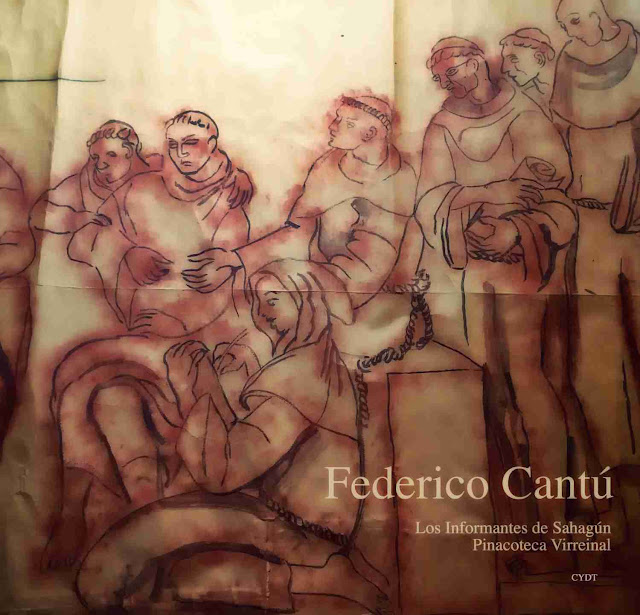jueves, 12 de noviembre de 2015
lunes, 9 de noviembre de 2015
viernes, 6 de noviembre de 2015
La obra aquí reunida
ofrece un panorama de la producción artística de México, creada por muralistas
que participaron en el diseño de un nuevo discurso visual. Hombres y mujeres de
diferentes generaciones que se subieron a los andamios para dejar testimonio de
los acontecimientos históricos, políticos y sociales de un México en constante
transformación.
El florecimiento del
arte monumental y el movimiento muralista –reconocidos ambos como el
“Renacimiento mexicano”– se fortalece bajo la protección de José Vasconcelos en
1921, como Secretario de Educación Pública.
Encabezaron la lista
muralistas de la consolidada escuela mexicana de pintura: Dr. Atl, José
Clemente Orozco, David Alfaro Siqueiros y Diego Rivera, y se fortalece con la
llegada de la segunda generación de muralistas. Influencia fundamental para la
aparición de figuras como la de Rufino Tamayo, uno de los más fuertes oponentes
a este nacionalismo exacerbado.
Esta exposición
colectiva representa una revisión del trabajo realizado por tres generaciones
de muralistas miembros del Salón de la Plástica Mexicana: Federico Cantú,
1907-1989, Guillermo Ceniceros, Arturo Estrada, Arturo García Bustos, José
Hernández Delgadillo, 1927-2000, Rina Lazo, Daniel Manrique, 1939-2010, Adolfo
Mexiac, Fanny Rabel, 1922-2008, Aurora Reyes, 1908-1985 y Luis Y. Aragón.
La obra de esta
generación de muralistas se fue incorporando al entorno de la modernidad, en
espacios públicos masivos como las estaciones del metro de la ciudad de México,
los muros de los barrios y unidades habitacionales, entre otros inmuebles.
El conjunto permitirá
conocer más ampliamente a los hombres y mujeres que han dejado este importante
patrimonio, el proceso de producción de la obra monumental a través de piezas
de mediano y gran formato, bocetos, fotografías y documentos de los artistas,
además de reproducciones a escala de los murales que se encuentran en espacios
públicos.
La actividad se realiza
en el marco de actividades del sesenta y seis aniversario del Salón de la
Plástica Mexicana y décimo aniversario del Centro Cultural del México
Contemporáneo.
La muestra se llevará a
cabo del 11 de noviembre al 9 de diciembre de martes a domingo 10:00 a 18:00
horas en la sede del centro Cultural del México Contemporáneo, Leandro Valle #
20 colonia Centro, México D.F.
domingo, 18 de octubre de 2015
domingo, 27 de septiembre de 2015

En 1954 Federico Cantú se da a la tarea de pintar una obra mural al fresco
En el Museo Regional de Morelia, el tema lo titulo “Los
Cuatro Jinetes del Apocalipsis”
La iconografía sumamente cautivante , coloca a los cuatro jinetes cabalgando
sobre el lago de Pátzcuaro , ( figura central )
separados por la disposición arquitectónica quedan dos murales restantes
, uno relata la batalla del ejercito Español y a el lado opuesto los arqueros Tarascos
Estas calcas son los
bocetos del trazo final de la obra mural.
sábado, 26 de septiembre de 2015
lunes, 21 de septiembre de 2015
miércoles, 16 de septiembre de 2015
Colección de Arte Cantú Y de
Teresa
Mexican Art &
Life (1938-1939)
Mexican Art & Life was an
English-language periodical published by Mexico’s Departamento Autónomo de
Prensa y Publicidad in 1938-1939. Issues cost 15 cents per issue or 50 cents
for a year’s subscription. UTSA Libraries Special Collections holds six of the
seven issues published.
Mexican Art & Life’s topical content is fairly consistent throughout its brief
history. Most issues feature a mix of travel-guide-like promotionals about
tourist destinations, articles on artistic practices or traditions, profiles of
Mexican artists, and commentaries on social or economic issues, as well as
occasional prose or fiction pieces.
The very first issue (Jan. 1938)
opens with an effusive paean to Mexico City, highlighting its Aztec history and
its many North American firsts:
Issue No. 3 (July 1938) follows up
with J. Rodolfo Lozada’s description of a trip to Yucatan, appealing to potential
tourists with lines such as, “The soul of Merida imprisons and bewitches the
wayfarer” and “Awaiting [the traveler] are the ruins of a civilization which,
until a few years ago, only interested the archaeologist but now attract poet
and philosopher alike.” Other featured sites include the Aztec ruins at
Malinalco and the Iturbide Palace (April 1938), as well as Monte Alban and San
Miguel de Allende (Oct. 1938).
Art history topics include Oaxacan
pottery (April 1938), Mexican lithographs (July 1938), Political Caricature in
Mexico (July 1938), 19th century photographic portraits (Oct. 1938), and Aztec
animal figurines (April 1939), among others. Artists profiled over the course
of the magazine include: landscape artist and portraitist Argüelles Bringas and
oil painter Francisco Gutierrez (April 1938); painter Jesus Guerrero Galvan,
wax-and-fabric modeler Luis Hidalgo, and landscapist Dr. Atl (July 1938);
landscapist Jose Maria Velasco and painter Federico Cantú (Oct. 1938); and
photographer Majuel Alvarez Bravo and painter Agustin Lazo (April 1939).
Seeming sometimes at odds with the
celebratory tone and arts & culture of the rest of the magazine are
occasional articles that explicitly address politics and economics. “The Moving
Forces in Mexican Life” (Jan. 1938) draws on a lecture delivered by Dr. Ramon
Beteta, then under-secretary of the Foreign Office” and focuses on the role of
the Mexican Revolution as a social force, its development and future.
“The Indian Problem” (Oct. 1938)
and “Mexico’s Demographic Policy” (April 1939) both make for particularly
uncomfortable reading, although they likely reflected mainstream opinion at the
time.The latter article is especially disturbing when the modern reader looks
at it through the lens of global events of 1939. Author Gilberto Loyo
devotes several paragraphs to discussing immigrants and their relative
desirability based on ethnicity or national origin. In particular, he
discourages Jewish refugees, stating that “The demographic, economic and social
characteristics of the Jews do not make them desirable for Mexico.” On the
other hand, he espouses Spanish immigration (by Spaniards fleeing the Spanish
Civil War) with the explanation that, “a crossing between the Spanish immigrant
and the predominantly indigenous half-breed may take place.”
Suscribirse a:
Comentarios (Atom)
















